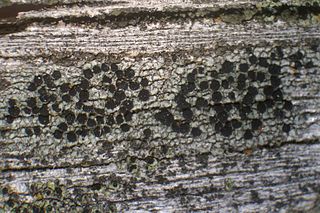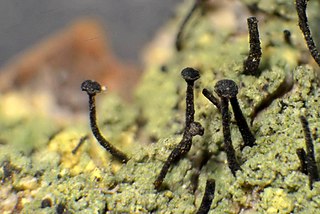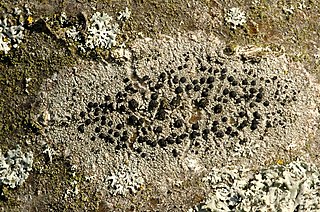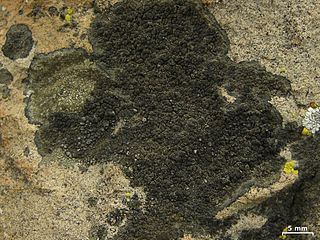
Alexander Segger George is a Western Australian botanist. He is the authority on the plant genera Banksia and Dryandra. The "bizarre" Restionaceae genus Alexgeorgea was named in his honour in 1976.

Buellia is a genus of fungi in the family Caliciaceae. The fungi are usually part of a crustose lichen. In this case, the lichen species is given the same name as the fungus. But members may also grow as parasites on lichens (lichenicolous). The algae in the lichen is always a member of the genus Trebouxia.

The Caliciaceae are a family of mostly lichen-forming fungi belonging to the class Lecanoromycetes in the division Ascomycota. Although the family has had its classification changed several times throughout its taxonomic history, the use of modern molecular phylogenetic methods have helped to establish its current placement in the order Caliciales. Caliciaceae contains 36 genera and about 600 species. The largest genus is Buellia, with around 300 species; there are more than a dozen genera that contain only a single species.

Buellia spuria, the disc lichen, is a white to light ashy gray crustose areolate lichen that grows on rocks (epilithic) in montane habitats. It has a black edge from the conspicuous, more or less continuous prothallus, which can also be seen in the cracks between the areolas forming a hypothallus, and in sharp contrast with the whitish or ashy colored areolas. It prefers mafic (siliceous) rock substrates. In Joshua Tree National Park is can be seen on vertical granite and gneiss faces in washes. It is common worldwide in the Northern Hemisphere. It is very common in the Sonoran Desert from southern California to Arizona, Baja California, and Sonora, Chihuahua, and Sinaloa, Mexico.

Buellia disciformis, the boreal button lichen, is a thin, bluish to pale gray rimose to areolate crustose lichen that grows on bark in temperate forests in the northern USA and Europe, and at high altitudes in Arizona, down to 500 metres (1,600 ft) in coastal areas of California. Flat apothecia with black discs are .2-.7 mm in diameter and sessile, with noticeable lecideine margins. Lichen spot tests are negative except for K+ yellow. Secondary metabolites include atranorin, fulgidin, and sometimes traces of fulgoicin and norfulgoicin. B. erubescens is similar and more often found on wood than the bark loving B. disciformis, and has smaller spores.

Buellia badia, the parasitic button lichen, is a dark chocolate-brown crustose areolate lichen of Europe, northern Africa, and North America that starts as a parasite growing on other lichens, such as Aspicilia phaea, gradually then becoming independent growing on rock (sometimes also on hardwood. Areoles may be contiguous or dispersed. Lecideine apothecia are 0.3 to 0.9 mm in diameter with black discs, that are initially flat, then become strongly convex as they age. Lichen spot tests are all negative. There are no known secondary metabolites as of. It is similar in appearance and other ways to the chocolate brown Dimelaena californica, which also starts off as a parasite on other lichens, and has spores of similar shape, size, and internal construction. D. californica has not been found on wood, is more preferential as to the lichens it starts growing on, and commonly has norstictic acid as a secondary metabolite. Some think they should be included in a new, third genus.
Hypocenomyce tinderryensis is a species of crustose lichen in the family Ophioparmaceae. It was described as a new species in 2007 by Australian lichenologist John Alan Elix. The type was collected in Tinderry Range in New South Wales, for which it is named. There it was found growing on a dead Eucalyptus trunk at an elevation of 1,200 m (3,900 ft). It somewhat resembles the type species of Hypocenomyce, H. scalaris, but it can be distinguished from that lichen by its smaller apothecia, longer ascospores, and differences in the morphology of the squamules (scales) that comprise the thallus.
Fluctua is a lichen genus in the family Caliciaceae. It is monotypic, containing the single crustose lichen species Fluctua megapotamica. The genus was circumscribed by Austrian lichenologist Bernhard Marbach in 2000. It was one of several segregate genera proposed by Marbach in his 2000 revision of American species of Buellia. The lichen is found in Brazil and Uruguay.

Catillaria is a genus of crustose lichens in the family Catillariaceae. The genus was circumscribed by Italian lichenologist Abramo Bartolommeo Massalongo in 1852. It is the type genus of Catillariaceae, which was circumscribed by Austrian lichenologist Josef Hafellner in 1984.
Buellia gypsyensis is a species of crustose lichen in the family Caliciaceae. Found in the Falkland Islands, it was described as a new species in 2019 by British lichenologist Alan Fryday. The type was collected from Gypsy Cove near Port Stanley in East Falkland, where it was found growing on a north-facing rock; it is named for its type locality. The main distinguishing characteristics of the lichen are its filiform (threadlike) conidia and the presence of 5-O-methylhiascic acid as the major secondary chemical in the thallus.
Hydropunctaria alaskana is a species of crustose lichen in the family Verrucariaceae. Found in Alaska, it was described as a new species in 2020 by Holger Thüs and Sergio Pérez-Ortega. The type specimen was collected from the Hoonah-Angoon Census Area in Glacier Bay National Park, where it was found growing on metamorphic rocks beside a creek. Buellia coniops and Verrucaria aethiobola were other lichens on the same rock. Hydropunctaria alaskana is also known to occur on Mitkof Island in Alaska, and on Vancouver Island in British Columbia.
Buellia quarryana is a species of crustose lichen in the family Caliciaceae. Found in southeastern Australia, it was described as a new species in 2020 by lichenologists John Elix and Patrick McCarthy. The type specimen was collected from Quarry Beach in East Gippsland (Victoria), where it was found growing on siliceous rocks along the seashore. The specific epithet refers to the type locality. It has also been found on the coast of southern New South Wales.
Buellia sharpiana is a species of crustose lichen in the family Physciaceae. It was formally described as a new species in 2013 by lichenologists James Lendemer and Richard Harris. The type specimen was collected from the summit area of Mount Le Conte at an altitude of 6,300 ft (1,900 m). The specific epithet sharpiana honors Evelyn Bunches Sharp, wife of bryologist Aaron J. Sharp. The Sharps collected samples for the cryptogamic herbarium at the University of Tennessee at Knoxville, especially after the original collection was destroyed by a fire in 1998.
Buellia magaliesbergensis is a species of crustose lichen in the family Caliciaceae. Found in South Africa, it was formally described as a new species in 2021 by lichenologists John Alan Elix and Helmut Mayrhofer. The type specimen was collected in the Magaliesberg Range, at an altitude of 1,720 m (5,640 ft). Here the saxicolous lichen was found growing on rocks on the ground. The species epithet refers to the type locality, which is the only location where the lichen has been documented. The results of standard chemical spot tests are: thallus K+ (yellow), P+ (yellow-orange), and C–. Buellia magaliesbergensis contains norstictic acid as a major secondary chemical, and connorstictic acid as a minor compound.
Buellia subeffigurata is a species of crustose lichen in the family Caliciaceae. Found in South Africa, it was formally described as a new species in 2021 by John Alan Elix, Helmut Mayrhofer, and Wolfgang Wetschnig. The type specimen was collected in the Knersvlakte, at an altitude of 150 m (490 ft). Here the saxicolous lichen was found growing on quartziferous rock. The species epithet refers to its subeffigurate marginal lobes. The results of standard chemical spot tests are: thallus K+ (yellow), P+ (yellow-orange), and C–. Buellia subeffigurata contains thiophanic acid as a major secondary chemical, and isoarthothelin and atranorin as minor compounds.

Ochrolechia africana, commonly known as the frosty saucer lichen, is a species of crustose and corticolous (bark-dwelling) lichen in the family Ochrolechiaceae. It is a widely distributed species, found in tropical and subtropical areas of southern Africa, Asia, Australia, North America, and South America. The lichen is characterized by the presence of a white "frosty" or powdery apothecia.
Ramboldia blastidiata is a species of saxicolous (rock-dwelling) and crustose lichen in the family Lecanoraceae. Found in Australia, it was formally described as a new species in 2007 by lichenologists Gintaras Kantvilas and John Elix. The type specimen was collected by the first author from the western slopes of Strzelecki Peaks on Flinders Island (Tasmania) at an altitude of 150 m (490 ft); here, in dry sclerophyll forest, it was found growing on a granite boulder. The lichen forms pale grey-green, olive-green to dull olive-brown crust-like patches up to 30 cm (12 in) wide. The authors suggest that it is widespread in temperate Australia and Tasmania, but not commonly collected. Others saxicolous lichens that it usually grows with include Ramboldia petraeoides, Lecanora farinacea, Xanthoparmelia mougeotina, and species from the genera Buellia and Rhizocarpon. The specific epithet blastidiata refers to the presence of blastidia, which are vegetative propagules that contain mycobiont and photobiont and are produced by yeast-like budding.
Buellia georgei is a species of lichen in the family Caliciaceae. Found in Australia, it was formally described as a new species in 2001 by lichenologists Ulrike Trinkaus, Helmut Mayrhofer, and John Elix. The type specimen was collected in Yanchep National Park ; here it was found growing on soft limestone. It has also been recorded from South Australia, New South Wales, and the Australian Capital Territory; preferred habitats are calcareous outcrops, on thin soil over limestone, or rarely on calcareous soil. The lichen produces some secondary compounds: arthrothelin as a major metabolite, and minor amounts of 4,5-dichloronorlichexanthone and thiophanic acid. The specific epithet honours Western Australian botanist Alex George.
Buellia lobata is a species of terricolous (soil-dwelling) lichen in the family Caliciaceae. Found in Australia, it was formally described as a new species in 2001 by lichenologists Ulrike Trinkaus and John Elix. The type specimen was collected in Blanchetown ; here, in a parking area after the bridge, on the east side of the Murray River, the lichen was found growing on soil. It has also been recorded from Western Australia. The lichen occurs on calcareous soil in mallee, often with other terricolous lichens including species of Endocarpon, Toninia, Eremastriella crystallifera, Fulgensia bracteata, and Psora decipiens. Secondary compounds that occur in the lichen include arthothelin and thuringione as major components, and minor amounts of 4,5-dichloronorlichexanthone and thiophanic acid. The species epithet lobata refers to the distinct lobes that comprise the thallus.







